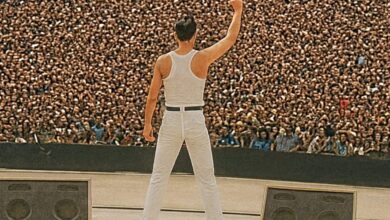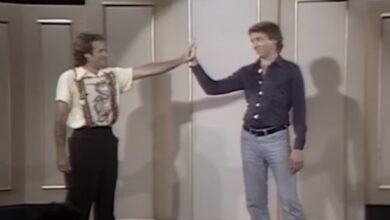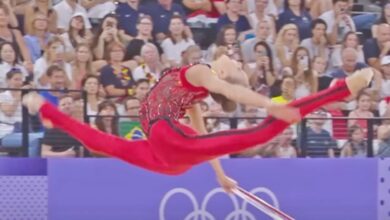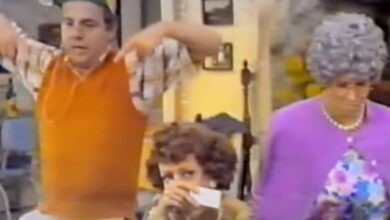Jerry Lee Lewis’ “Great Balls of Fire” Ignites Rock and Roll with Raw Energy and Unstoppable Spirit in 1957
When “Great Balls of Fire” exploded onto the scene in 1957, it wasn’t just another hit—it was a seismic event that rocked the foundations of American music. Performed by Jerry Lee Lewis, the song became one of the most recognizable anthems of early rock and roll. Its pounding piano, raucous vocals, and outrageous energy launched it to No. 2 on the Billboard pop chart, and it reached No. 1 on both the country and R&B charts. The track was more than just a chart-topper—it was a bold, electrifying declaration of a new musical era.
Born in Ferriday, Louisiana, in 1935, Jerry Lee Lewis was steeped in the Southern traditions of gospel, country, and blues from an early age. A piano prodigy, he had an uncanny ability to channel intense emotional energy into his playing. Known for his wild performance style, including kicking over piano stools and playing with his feet, Lewis quickly earned a reputation as a showman who broke the mold. Signed to Sun Records—the same label that launched Elvis Presley—Lewis stood out not just for his talent, but for his unfiltered, almost reckless abandon.
“Great Balls of Fire” was written by the songwriting team of Otis Blackwell and Jack Hammer, who had previously penned hits for Elvis Presley. The song’s title and lyrics were controversial at the time, seen as provocative and suggestive in an era still tightly bound by conservative social norms. Lewis himself was initially uncomfortable with recording it, citing its clash with his religious beliefs. But Sam Phillips, founder of Sun Records, insisted, and after intense sessions, Lewis delivered one of the most memorable performances in rock history.
The recording itself was raw, powerful, and almost chaotic—qualities that became hallmarks of Lewis’s style. Unlike many contemporaries who leaned on polished harmonies or lush orchestration, “Great Balls of Fire” was stripped-down and explosive. The track featured Lewis’s ferocious boogie-woogie piano front and center, supported by a minimal backing of guitar, drums, and bass. His vocals were wild and breathy, rising to shouts and dropping to seductive murmurs—all in a span of just under two minutes.
From the moment it hit radio waves, the song became a sensation. Its frenzied rhythm and audacious energy made it irresistible to a generation hungry for rebellion and rhythm. It held a firm grip on the charts, staying in the top ten for multiple weeks, and selling over a million copies within the first ten days. Critics were divided—some heralded its raw innovation, while others decried it as vulgar noise. But regardless of opinion, no one could ignore its impact.
Culturally, “Great Balls of Fire” represented a turning point in how youth engaged with music. It challenged the boundaries of decency and musical structure, and in doing so, it helped define the rebellious spirit of rock and roll. It pushed the piano to the front of the stage, traditionally dominated by guitar or voice, and introduced an entirely new kind of showmanship that blended musicianship with raw charisma. It was theatrical, unapologetic, and wholly original.
The success of the single propelled Jerry Lee Lewis into instant stardom, securing television appearances and international tours. Suddenly, he was a headliner, not just in the United States, but also across Europe. For a brief moment, he stood shoulder to shoulder with Elvis Presley in defining what rock and roll could be. While controversy would later derail much of his mainstream momentum, “Great Balls of Fire” remained a high point in his early ascent.
Beyond its impact on Lewis’s own career, the song inspired countless artists who followed. Its unrestrained approach to vocal delivery and piano performance set a new standard for intensity in rock music. Musicians like Little Richard, Elton John, and even Queen’s Freddie Mercury would draw upon that same blend of flamboyance and force in their own performances. The track helped broaden the idea of what a rock frontman could be—not just a singer, but a force of nature.
Over the years, “Great Balls of Fire” has been reinterpreted by many performers, from Tom Jones to Dolly Parton. It even became the centerpiece of the 1989 biographical film of the same name, starring Dennis Quaid as Jerry Lee Lewis. Each new rendition further cemented its legacy as a song that refused to be tamed, growing in stature with every generation that rediscovered its blistering brilliance.
In 1957, when America was still adjusting to the idea of teenagers having their own culture, the song served as a rallying cry. Yet, just a year later, Lewis’s career would be derailed by scandal, when news broke that he had married his 13-year-old cousin. The backlash was swift and severe, especially in the U.K., where his tour was abruptly canceled. Yet, despite the controversy, the song’s legend only grew with time.
More than six decades after its release, “Great Balls of Fire” continues to ignite stages and playlists around the world. It is regularly featured in films, commercials, and documentaries about the birth of rock and roll. Its inclusion in the Rock and Roll Hall of Fame’s “500 Songs That Shaped Rock and Roll” is a testament to its influence and staying power.
The song also introduced a new approach to production—raw, unpolished, and urgent. It influenced the garage rock and punk movements that would follow decades later. Jerry Lee Lewis’s technique of pounding the piano like a drum, combined with his gritty vocal style, became a template for emotional immediacy in music. It wasn’t just what he sang—it was how he attacked every note with conviction.
While Jerry Lee Lewis would receive numerous honors later in life, including his 1986 induction into the Rock and Roll Hall of Fame, “Great Balls of Fire” remains the track most synonymous with his legacy. No other song captured his fearless spirit, his rebellious streak, and his manic genius quite like this one.
In the end, “Great Balls of Fire” wasn’t just a hit single. It was a shot of adrenaline to the chest of American pop culture. It pushed boundaries musically and socially, electrifying audiences with its ferocity. For Jerry Lee Lewis, it was the moment he became a legend—and for rock and roll, it was proof that nothing would ever be the same again.





